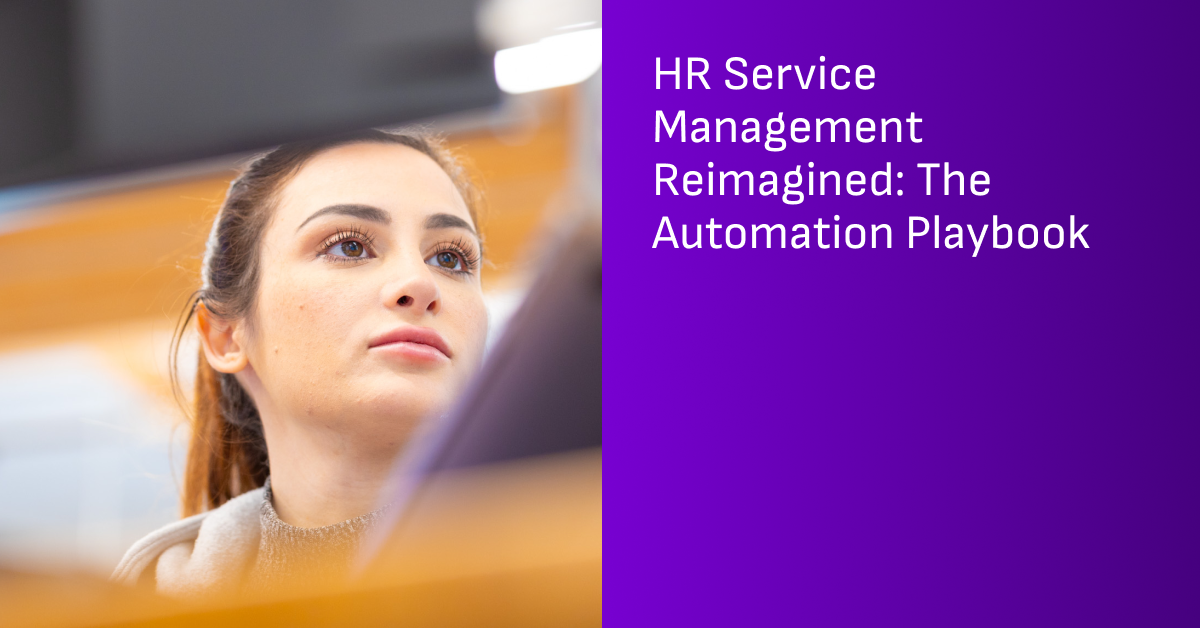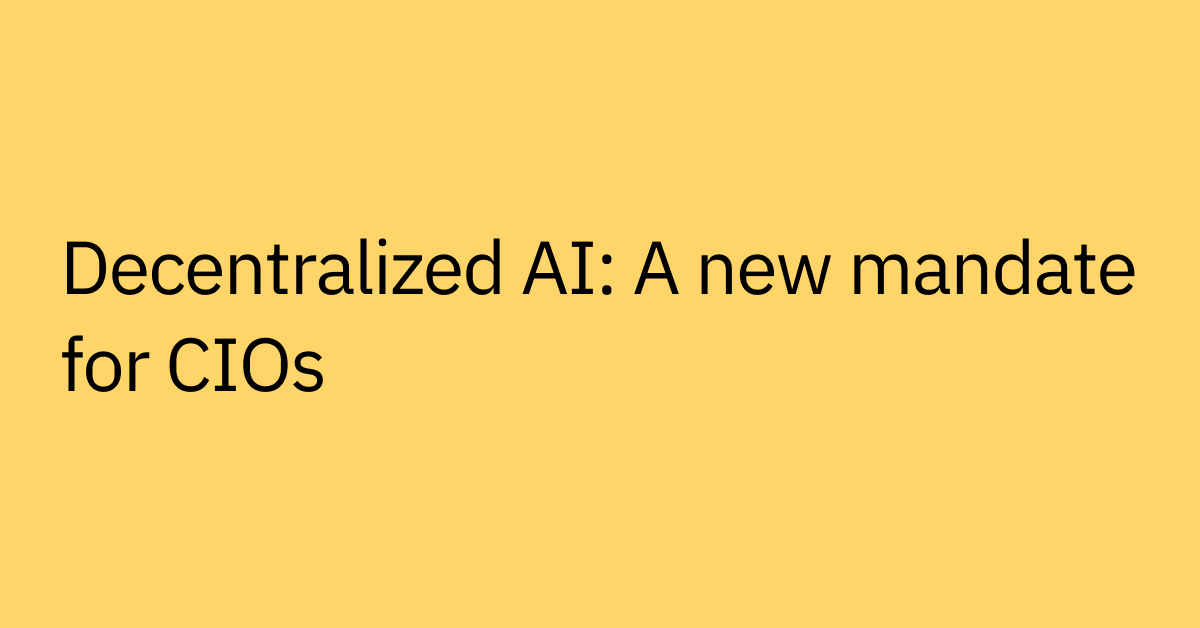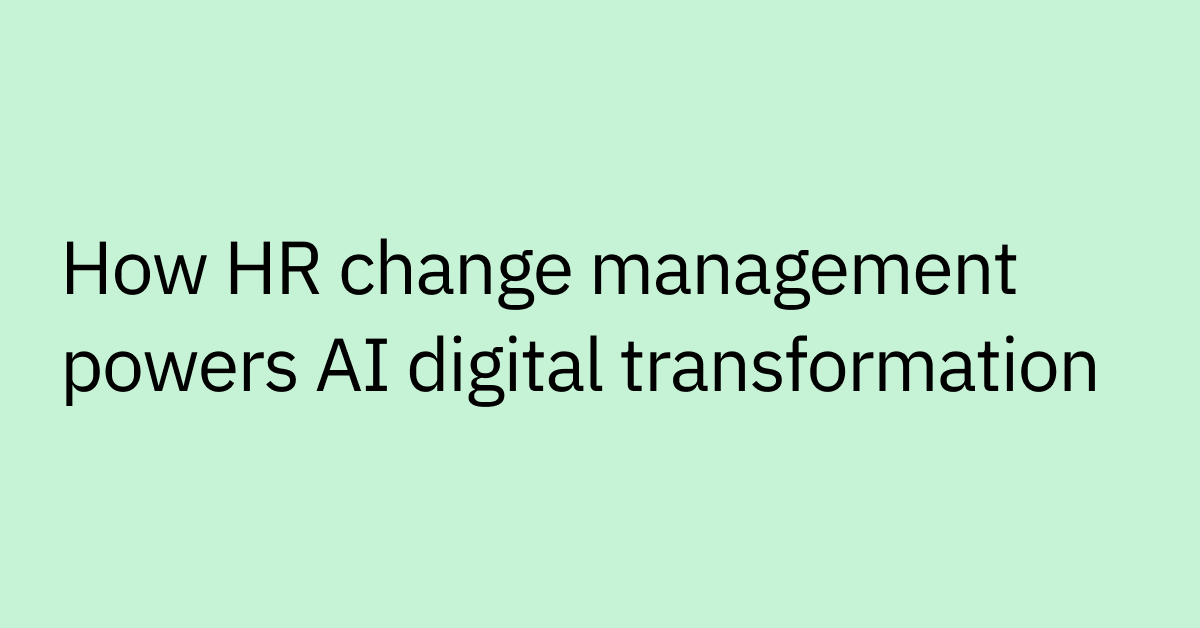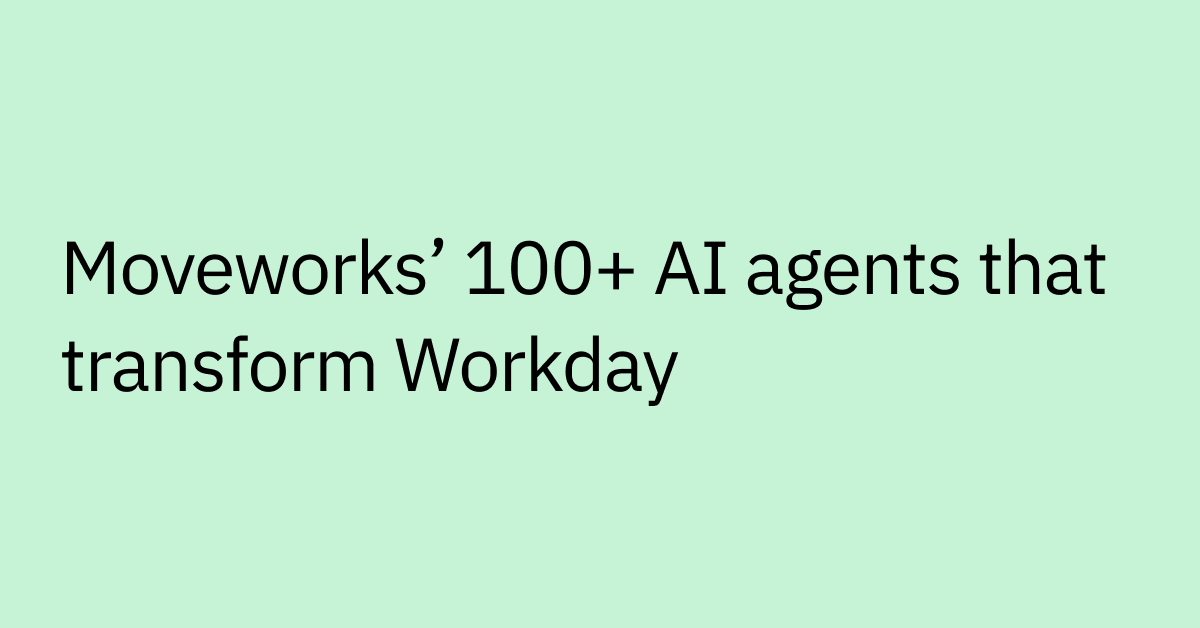Table of contents
Highlights
- Manual HR processes are time consuming– they prevent HR from focusing on strategic work, slow down support, and frustrate employees.
- AI-powered HR service management turns reactive processes into proactive, intelligent support that delivers instant answers across multiple channels.
- Build trust and buy-in with clear ROI, clean data management, and transparent communication about AI's role (enhancing productivity).
- Prioritize employee experience (omnichannel support, intuitive design), seamless integration with existing systems, and built-in compliance features.
- Measure success with three lenses: operational efficiency (resolution times, automation rates), employee experience (adoption rates, satisfaction scores), and business value (cost savings, risk reduction).
Is your HR department drowning in routine requests, like benefits questions and policy clarifications, while strategic initiatives take a backseat?
HR staff report spending up to 57% of their time on administrative tasks, leaving little bandwidth for the strategic initiatives that actually drive business value.
These challenges aren't limited to HR, with slow manual processes frustrating your employees too with bottlenecked service delivery. When someone needs help with updating dependent information or understanding leave policy, they expect instant answers (not a ticket that sits in a queue for days).
This disconnect between expectations and reality is costing your team more than time. It's impacting employee engagement, productivity, and your ability to focus on building a thriving workplace culture.
It's time to reimagine your HR service management—with AI and automation that shift HR from reactive ticketing to proactive, personalized support.
What is HR service management?
Human resources service management (HRSM) is the systematic approach to delivering and managing HR services through standardized processes, modern technology platforms, and clear service level agreements (SLAs).
When done right, it turns HR from a ticket-driven, reactive function into a proactive service provider that drives efficiency, engagement, and measurable business outcomes at scale.
HRSM covers the full spectrum of employee interactions: onboarding and offboarding, payroll support, benefits, compliance tracking, performance management, and day-to-day employee requests. It's the operational core that keeps HR touchpoints delivering consistent, high-quality, and compliant experiences.
Today's HRSM platforms typically embed AI for greater efficiency and faster support. Instead of employees emailing HR directly or walking to an office, they can now access AI-powered self-service in the tools they already use (Slack, Microsoft Teams, mobile), conversational AI assistants, and automated workflows.
With modern HRSM, you can get instant, proactive, and personalized support that anticipates employee needs and resolves issues before they escalate.
Why HR service delivery is broken and how AI-powered HRSM fixes it
HR teams are under pressure to deliver consumer-grade support, but legacy processes can’t keep up. These are the biggest friction points. How AI-powered HRSM solves them:
- Disconnected systems → Unified experience
Employees bounce between payroll, benefits, and HRIS systems, re-entering the same data.
AI-powered HRSM can integrate and unify platforms like Workday, SAP Concur, and ADP.
- Slow response times → Instant answers
Manual queues leave employees waiting days. Integrating an AI assistant with your HRSM can resolve routine requests instantly and route complex cases to the right expert.
- Limited visibility → Data-driven insights
Leaders can’t track resolution times, common issues, or satisfaction. AI HRSM unifies dashboards show efficiency, adoption, and friction points in real time.
- Low adoption → Consumer-grade experience
Clunky portals discourage self-service. Integrating an AI assistant with your HRSM creates omnichannel, intuitive support in Slack, Teams, and on the web for ease of adoption and trust.
- Scaling challenges → Built-in compliance and automation
Manual processes can’t keep pace with global growth or regulations. Using an AI assistant with HRSM helps deliver consistent, compliant support at scale.
Key components of modern HR service management
The foundation of HRSM is simpler than you might think. Most effective platforms start with four core building components:
- Centralized HR knowledge base and search that makes policies, FAQs, and step-by-step guides easy to find in one place.
- Smart case management and routing to enable requests are tracked, visible, and automatically assigned to the right specialist.
- Automated workflows to handle recurring HR processes, like employee onboarding, leave requests, and payroll changes.
- Analytics and reporting to measure service performance, spot bottlenecks, and improve continuously.
But the bar is rising fast, and basic case tracking alone just won't cut it anymore. These modern capabilities are quickly becoming must-haves:
- AI-powered, conversational self-service: Employees already expect instant answers using natural language, not buried FAQs they have to hunt for. And with today’s distributed workforces, multilingual support will become a core functionality, not a premium feature.
- Proactive, intelligent support: Your HR systems will need to be proactive about things like benefits deadline reminders and policy suggestions triggered by role changes.
- Omnichannel access: Employees will expect this support to happen where they're already working (Slack, Microsoft Teams, web browser), not in another portal they have to remember to check.
- End-to-end automation of common workflows: Routine workflows like onboarding or policy acknowledgments should run start to finish with no manual handoffs.
- Real-time analytics and insights: Real-time analytics will give you the insights needed to prove ROI and keep improving processes over time.
- Embedded compliance and security controls: Embedded compliance and security controls will continue to be non-negotiable. Role-based access, audit trails, and automated enforcement for GDPR, HIPAA, and other regulations protect your organization while reducing risk.
HR service management is ultimately evolving from a digital help desk into an intelligent employee experience layer that can anticipate needs and deliver instant value.
How AI transforms HR service management
AI integration is restructuring traditional HR service management, moving the function's focus away from routine, transactional tasks. This transformation improves organizational efficiency for HR teams while providing employees with quicker access to necessary resources and task completion. This change is implemented primarily through AI-powered workflow automations and agentic AI assistants.
AI-workflow automations for efficiency
AI-powered automations are utilized to execute high-volume, rules-based processes consistently. For HR teams, this means reducing the need for manual data handling in areas like resume screening, interview scheduling, and updating employee records across disparate systems. This process redirection allows HR staff to allocate effort toward complex personnel matters and strategic planning.
For employees, automation yields practical benefits in the speed and accuracy of transactions. This includes a more efficient acclimation process during onboarding due to automated paperwork, and more accurate processing of routine changes related to payroll and benefits administration, contributing to measurable time savings.
The function of an agentic AI assistant
The agentic AI assistant operates as an autonomous, goal-oriented system integrated across all essential HR platforms (HRIS, payroll, benefits) to provide instant employee support. For HR professionals, the assistant is able to manage for complex, multi-step employee requests end to end.
When an employee query requires action across several systems (e.g., initiating a leave request or requesting specialized training), an agentic AI assistant can reasons through the necessary steps and executes them for end-to-end task completion. This capability transfers workload away from HR specialists and enables them to address higher-value organizational concerns.
Better automation for better service, employee outcomes
Many organizations tried to solve HR service automation with RPA or iPaaS tools. While these can automate simple, rules-based tasks or connect siloed systems, they fall short for employee support at scale because employee requests are unstructured, contextual, and constantly changing.
- Rigid RPA scripts break when processes change.
- iPaaS integrations take resources to build and maintain, moving data between systems but don’t improve the employee experience.
The result? More backend plumbing, but employees still don’t get instant, personalized answers.
AI can provide an instant, scalable, and adaptive alternative to manual processes. AI assistants are one part of this ecosystem—they resolve routine requests, route complex cases, and streamline workflows—while AI analytics surface key employee insights to improve service performance and decision-making over time.
This changes HR service for the better, helping leaders become more proactive and strategic while employees gain fast, contextual support in the tools they already use—Slack, Teams, or web.
Explore actionable use cases and strategies to empower your HR team and drive meaningful change with agentic AI.
Automating repetitive workflows
Automation helps save time, reduce costs, and ensure consistency. But the real value is creating a connected employee experience. When HR systems work with the rest of your applications (like Slack and ServiceNow) work together, employees can get everything they need in one place.
With agentic AI support, they can even immediately take action with high-impact workflows, like onboarding, policy acknowledgments, leave requests, and payroll/benefits updates.
Scaling HR support
As workforces grow, HR headcount shouldn’t have to scale in lockstep. Automation helps teams handle seasonal spikes, global expansion, and rising volumes without burning out.
With agentic AI-powered assistants resolving routine requests and intelligent triage routing complex ones, HR can reduce resolution times and free staff to focus on strategic, people-first initiatives.
Strengthening security and compliance
Modern HRSM must embed compliance and data protection workflows. Automated role-based access, and policy enforcement reduce risk while ensuring GDPR, HIPAA, and other regulations are consistently applied.
Best practices for getting started with AI-driven HR service delivery and management
Successful HR transformation takes strategic planning and organizational commitment. These proven approaches can support effective implementation while building executive buy-in and driving employee adoption.
Define clear goals and prioritize use cases
Rather than implementing AI everywhere at once, start by identifying specific pain points or time-consuming HR tasks within your HR service delivery processes. High-value areas for initial AI implementation often include:
- Employee self-service for common questions about policies, benefits, and procedures
- Onboarding automation to streamline new hire experiences and reduce manual coordination
- Data and analytics to provide visibility into HR performance and employee satisfaction
Focus on use cases where you can clearly demonstrate business value quickly, then expand automation to additional workflows based on initial success.
Focus on ethics, data, and transparency
Your AI is only as good as its data. Clean, well-governed data helps prevent discriminatory outcomes and protects sensitive employee information from exposure—reducing both ethical and compliance risks.
Start with the basics: audit your historical data, establish clear privacy guidelines, and align with GDPR and CCPA requirements. Work with your IT and legal teams to lock down security and privacy protocols.
Most importantly, be transparent with employees about how AI supports (but doesn’t replace) human decision-making. Regular audits with human oversight can help keep everything fair and accurate.
Build a culture of readiness and collaboration
Change is hard, but you can make AI adoption smoother by starting small and showing quick wins.
Launch pilot projects with high success rates, like automating benefits questions or streamlining time-off requests. When employees see AI solving their daily frustrations in seconds, not days, resistance can melt away.
Again, position AI as a productivity booster, not a job threat. Provide training that shows employees how AI can handle boring, everyday tasks so they can focus on work that actually matters.
Choosing the right HR service management software
The crowded HR tech market makes evaluation challenging, especially from an executive perspective. The wrong choice can lead to wasted investment, poor adoption, or stalled transformation efforts.
Look for these features and capabilities to ensure your chosen solution delivers where it counts.
People: Employee and HR team experience
- Omnichannel support allows employees to access HR help from tools they already use (Slack, Teams, mobile apps, web portals).
- Personalization at scale delivers role, location, and language-based support so every employee gets relevant answers, not generic responses.
- Ease of adoption through intuitive design means employees actually want to use the system instead of working around it.
Technology: AI and integration capabilities
- AI-powered automation and agentic capabilities can create intelligent workflows that actually understand context and adapt to complex employee needs.
- Seamless integration is essential—your HRSM platform should connect with existing HRIS, payroll, and collaboration tools to create a single, connected experience. Multiple logins and manual data transfers can harm adoption fast.
- Scalability and flexibility help your platform grow with your business without requiring expensive rebuilds every few years.
- Mobile-first design is a major win for frontline and deskless workers who don't sit at computers all day.
Governance: Compliance, trust, and ROI
- Advanced analytics and reporting track the metrics that matter, such as adoption rates, resolution times, and cost savings, so you can prove ROI and secure budget for expansion.
- Governance and ownership features provide the oversight executives need through role-based access and approval workflows, without turning every request into a bureaucratic nightmare.
- Built-in compliance and security handle GDPR, HIPAA, SOC 2, and CCPA requirements automatically, to protect sensitive data and avoid regulatory challenges.
- Future-proof design means your platform evolves with new regulations and AI advances instead of becoming expensive legacy tech.
With the right solutions in place, HR can become a strategic driver of employee experience and business performance—but you’ll need the right metrics to link outcomes back to HR transformation.
How to measure success: HR service management KPIs
Proving ROI and building executive buy-in takes clear data that demonstrates both operational improvements and strategic outcomes.
Group KPIs into three strategic categories for clarity and impact:
Efficiency and productivity metrics include mean time to resolution (MTTR) for HR requests, percentage of requests resolved automatically through self-service deflection, and average HR staff time saved per request. These metrics demonstrate operational improvements and cost reduction.
Employee experience and engagement indicators cover employee adoption rates of HRSM platforms and employee satisfaction (ESAT) scores for HR interactions, as well as Net Promoter Score (NPS) for HR services. These KPIs show how automation is improving the employee experience (or where focus may need to shift).
Business value and ROI measurements cover cost savings from automation, reduction in HR ticket volume over time, and compliance risk reduction through audit pass rates and fewer errors in sensitive processes.
Each organization will start from a different baseline, so focus on demonstrating consistent improvement over time rather than comparing against industry benchmarks. These KPIs can provide proof that HR service management is delivering on efficiency while becoming more strategic, measurable, and aligned with enterprise goals.
Empower your workforce with Moveworks
HR service management doesn't have to be so complicated. Moveworks makes it easier with 24/7, multilingual employee support delivered directly in the tools your people already use.
The Moveworks platform automates repetitive tasks like onboarding workflows, policy requests, and benefits updates, so your HR team can focus on culture, employee engagement, and retention.
Integrations with Workday, ServiceNow, and your other existing systems mean employees get unified support via Slack, Teams, or web browser, without app switching.
Built-in compliance features support enterprise security, while real-time analytics help you measure overall impact and show ROI to leadership.
Moveworks uses agentic AI (which understands context and intent) to deliver personalized HR support that scales with your business. With one centralized, comprehensive solution, you can provide the accelerated, reimagined HR service management experience your employees need to thrive.
Take your HR operations to the next level with Moveworks’ intelligent automation.
Frequently Asked Questions
Automation enhances rather than replaces human interaction by handling routine tasks so HR professionals can focus on meaningful employee conversations. Configure your automation to escalate sensitive issues to humans and use contextual data (such as role, location, or past interactions) to personalize automated responses.
Ensure your automation platform maintains compliance with GDPR, CCPA, and industry-specific regulations through automated policy enforcement. These safeguards reduce risk, protect brand trust, and give executives confidence that sensitive employee data is secure.
Regulatory compliance protects both employees and organizations from legal risks while ensuring fair treatment and data privacy. Automated HR systems must adapt to changing regulations across jurisdictions, making built-in compliance features essential for maintaining trust and avoiding penalties. Automation also minimizes human error in compliance-heavy processes, such as handling leave requests or payroll updates.
Employees will only use systems that are intuitive and accessible. Choose platforms that deliver support directly in the tools they already use (like Slack or Teams), offer multilingual capabilities, and provide a seamless, consumer-grade experience. Pair technology with clear communication, leadership sponsorship, and training to build trust and drive adoption.



